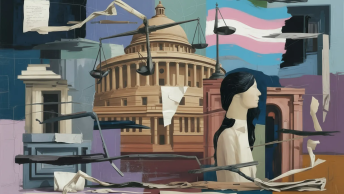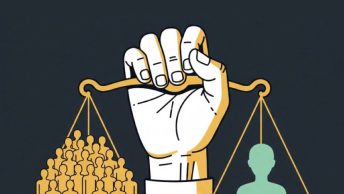On September 6, 2018 in the case of Navtej Singh Johar v. Union of India a five-judge constitutional bench of the Supreme Court headed by Chief Justice Dipak Misra unanimously rendered Section 377 of the Indian Penal Code unconstitutional insofar as it criminalises consensual homosexual relations between adults. The apex court in four separate but concurring judgements termed the 2013 Suresh Kumar Koushal judgement constitutionally impermissible and held Section 377 to be “irrational, indefensible and manifestly arbitrary”.
Legislative Antecedents of Section 377
First records of sodomy as a crime in English common law were chronicled in 1290 and later in 1300 in Fleta and Britton respectively. The Buggery Act of 1533, passed during the reign of Henry VIII, was England’s first civil sodomy law. It defined buggery as an “unnatural sexual act against the will of God and man” and criminalised anal penetration, bestiality, and in a broader sense, all forms of non-penile vaginal sexual intercourse. The Buggery Act re-enacted in 1563 became the model for the subsequent criminalisation of sodomy in the British colonies.
In India, a Draft Penal Code, 1837 was prepared with Clauses 361 and 362 which contained the anti-sodomy law and made a distinction between touching with consent and without consent. Finally, in 1861, the Indian Penal Code drafted by Lord Macaulay included Section 377 in Chapter XVI of the IPC titled “Of Offences Affecting the Human Body” which criminalises “unnatural sex”.
Section 377 states:
“377. Unnatural offences—Whoever voluntarily has carnal intercourse against the order of nature with any man, woman or animal, shall be punished with imprisonment for life, or with imprisonment of either description for a term which may extend to ten years, and shall also be liable to fine.
Explanation — Penetration is sufficient to constitute the carnal intercourse necessary to the offence described in this section.”
Courts’ interpretation of Section 377
Section 377 criminalises carnal intercourse against the order of nature and excludes only penile-vaginal intercourse from its ambit. The phrase ‘against the order of nature’ is vague and provides no guidance to determine what actions invite criminal sanction given the contextual nature of its meaning predicated on subjective notions of societal values. However, judicial interpretation of the acts falling within the ambit of section 377 has changed from non- procreative to imitative of sexual intercourse to sexual perversity. At one such instance, Gujarat High Court has observed that the act is imitative and against the order of nature since the particular orifice “is not meant for such carnal intercourse”.
How does Section 377 Target the LGBTQ+ Community?
According to the traditional Victorian moral and ethical standards on which Section 377 is based, sex is understood in purely functional terms and therefore, any non- procreative sexual activity is viewed to be ‘against the order of nature’. As is evident from a textual reading of the section, consent was immaterial for an offence under Section 377. Accordingly, this section criminalised private, consensual sexual acts between adults belonging to the lesbian, gay, bisexual and transgender and queer (LGBTQ+) community. As a corollary, consensual oral and anal sex in private is also treated to be unnatural.
For a long time, Section 377 had been used to oppress the sexual minorities i.e. the members of LGBTQ+ community by criminalising the sexual behaviour that forms an integral part of their identity. An entire section of the populace was considered ‘unconvicted felons’ and were outlawed by virtue of their sexuality, which is an inherent component of their identity. This impinges on their fundamental right to access justice as the risk of prosecution under Section 377 is hanging as the sword of Damocles. Gender right activists argue that Section 377 denies the LGBTQ+ community their rights to sexuality, sexual autonomy, choice of partner, life, privacy, dignity, equality and freedom of expression, along with other Fundamental Rights.
What was the Constitutional Challenge to Section 377?
The first step to decriminalize homosexual conduct was initiated by a petition by an NGO AIDS Bedhbhav Virodh Andolan (ABVA) in 1994 out of a growing concern over male sexual health and the HIV/AIDS epidemic and had earlier published a report titled ‘Less Than Gay: A Citizens’ Report on the Status of Homosexuality in India’. In 2001, Naz Foundation filed a public interest litigation challenging the constitutionality of Section 377 in the Delhi High Court which was later dismissed by the court, stating that the said body had no cause of action in the matter. The Naz Foundation filed a special leave petition before the Supreme Court which remitted the matter back to the High Court for reconsideration on merits. Subsequently, the Delhi High Court in a historic judgement in Naz Foundation v. Government of NCT of Delhi rendered Section 377 unconstitutional insofar as it criminalised consensual sexual acts of adults in private, as it violated Article 14, 19 and 21 of the Constitution. Section 377 still cast the net of criminality on non-consensual penile non- vaginal sex and penile non- vaginal sex involving minors as criminal conduct. By reading down the draconian colonial legacy of Section 377, the court condemned harassment against sexual minorities carried out by state officials. Following this progressive verdict, various appeals were made in the Supreme Court challenging the High Court’s decision. In 2013, a two-judge bench of the Supreme Court in the infamous case of Suresh Kumar Koushal & Anr v. Naz Foundation & Ors overturned the High Court’s decision and upheld the constitutional validity of Section 377 stating that it was the Parliament’s job to strike down laws. The Supreme Court reasoned that the Indian society was not ready for homosexuality. The judgement was highly criticized as it undermined constitutional morality upholding the criminalisation of gay sex on the basis of a hollow claims representative of which is that ‘miniscule fraction of the country’s population’ was affected. The decision was appealed in various review petitions which was quashed by the Supreme Court, followed by a curative plea to re-examine the original verdict but to no avail.
How did the Recent Petition Come Up?
In 2016, five writ petitions challenging Section 377 were filed by members of the LGBTQ+ community who have spent their lives living in the fear of being prosecuted: Navtej Singh Johar, Sunil Mehra, Ritu Dalmia, Aman Nath, and Ayesha Kapur. Another writ petition on behalf of 20 IIT students was also joined. In January 2018, a three judge bench referred the matter to a constitutional bench for a re-consideration of the decision in the Suresh Kumar Kaushal’s case. The court while referring the matter observed that Section 377 had the potential to destroy the individual autonomy and sexual orientation. In July 2018, a five-judge Constitutional bench comprising Chief Justice of India Dipak Misra, Justices D Y Chandrachud, R F Nariman, A M Khanwilkar and Indu Malhotra heard petitions challenging Section 377. On July 17, 2018, the apex court concluded hearing the arguments and reserved its verdict in the case Navtej Singh Johar v. Union of India.
Recent decisions in National Legal Services Authority v. Union of India & Ors and Justice K.S. Puttaswamy (Retd.) v. Union of India & Ors case had an impact on the Navtej Singh Johar judgement. In the 2013 NALSA judgment, ‘gender identity and sexual orientation’ had been emphasized and transgenders were declared a ‘third gender’. Similarly, in Puttaswamy, the Supreme Court observed sexual orientation as an important facet of right to privacy, and recognized right to privacy as a fundamental right under Article 21 of the Constitution. The Supreme Court actively condemned the Koushal judgment for overlooking rights and liberties of a minority citizen group. Overtutning the highly criticized judgment of Koushal v. Naz, the Court recognized the element of dignified life attached to the determination of sexual orientation along with other rights that of equality, privacy and freedom to express oneself among others.
Arguments advanced by the Petitioners
The petitioners argued that Section 377 violates different articles of the Indian Constitution. Section 377 violates Article 14 guaranteeing equality before law to all individuals as it fails the two tests- intelligible differentia and reasonable nexus test. They argued that there exists no intelligible difference between consenting adults engaging in ‘carnal intercourse against the order of nature’ and ‘carnal intercourse within the order of nature’; there is an absence of a ‘rational nexus’ between the classification and the purpose of the legislation. Moreover, the terms ‘carnal intercourse’ and ‘order of nature’ are vague and undefined, making the provision prone to arbitrary state action.
A crucial argument based on Article 15 was made stating that Section 377 violates the said Article as it discriminates against people on the basis of their sex as sex includes an individual’s sexual orientation.
Section 377 violates Article 19 by criminalising a particular sexual orientation and sexual expression. It has a chilling effect on the LGBTQ+ community as same- sex couples are denied their rights to fully express themselves in public. It also violates their right to form a personal and professional association as they are unable to identify themselves as LGBTQ+ due to fear of persecution. It has a deep psychological impact on the LGBTQ+ community as they are forced to hide their identities in the workplace, affecting their right to practice or carry on an occupation.
Section 377 violates Article 21 as the right to life and liberty includes the right to privacy, dignity and autonomy. One’s right to choose one’s partner is an intrinsic part of one’s personality and sexual orientation is an important component of one’s identity and privacy which is protected by Article 21. Section 377 by criminalising LGBTQ+ community’s sexual orientation, violates their right to choose their partner.
Arguments of the Respondents
The Government did not take any stand on consensual acts between adults in private and left the same to the ‘wisdom of the apex court’. The Centre prayed that the court should not go into other issues and/or rights of the LGBTQ+ persons beyond the constitutionality of Section 377. The original respondents of the curative petition stated that Section 377 only criminalises certain acts and not sexual orientation per se and that 95% of the Indian population was opposed to homosexual practices. They deemed Section 377 important to uphold the family system in India and to prevent the spread of HIV/AIDS. The respondents further argued that the court should not add or delete words like consent to the statute while interpreting it and that it should be left to the Parliament to decide the question of decriminalisation of homosexuality.
What does the Judgement say?
The Supreme Court held that Section 377, so far as it penalizes any consensual sexual relationship between two consenting adults, be it homosexuals, heterosexuals or lesbians is unconstitutional as it violates Articles 14, 15, 19 and 21 of the Indian Constitution. The Court observed that one’s sexual orientation is an innate and biological phenomena and any discrimination on its basis would violate fundamental right of freedom of expression. Holding the Indian Constitution to be a living and organic document which is capable of transforming and changing with time, emphasis was placed on constitutional morality to preserve the rule of law and the diverse nature of Indian society. The court observed that societal morality cannot be used to overturn the fundamental rights of even a single person. The judgement acknowledged that bodily autonomy is individualistic, a matter of choice and dignity and recognised homosexuals fundamental right to live with dignity. It hoped that this would further help in imbibing the spirit of fraternity, a crucial element of the preamble of the Consitution. Recognising that decriminalisation of homosexuality is only the first step, various measures like broadcasting regular programmes on public media, periodic sensitization programmes from public officials were proposed to make sure that wide publicity is given to the judgement and remove the social stigma which members of LGBTQ+ community have faced. The court observed that the LGBTQ+ persons deserve to live a life unshackled from the shadows of being ‘unapprehended felons’ and for that, they were said to possess full range of constitutional rights, including sexual orientation and choice of partner, equal citizenship and equal protection of laws.
What can be the Possible Legislative Responses?
Shashi Tharoor had earlier moved a private member bill to decriminalize consensual sex between adults of any gender which was unfortunately rejected by the Parliament. However, the Bill was not well-received by the House with 71 MPs voting against it. Given the progressive jurisprudence that is being developed around claim of rights, it is hoped that the legislature realizes the value of fundamental right to each individual keeping itself distant from majoritarian forces. With this judgement, it is hoped that well drafted laws are passed by the legislature to realize the civil liberties of the members of the LGBTQ+ community, and to actualise the hope that has been restored.
Gayatri Gupta is a student at the NALSAR University of Law, Hyderabad.








Very nice write up. Full of information. Great.
Comprehensive read. Great work!!
please keeop writing. i know this page is not known to many people but you guys are doing a great job… stick to it. very soon you will have the required number of followers. 🙂
Your point of view caught my eye and was very interesting. Thanks. I have a question for you. https://accounts.binance.com/ru-UA/register-person?ref=OMM3XK51